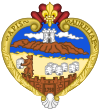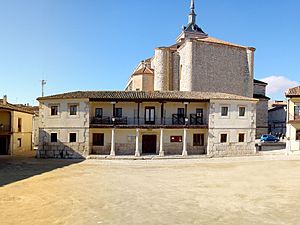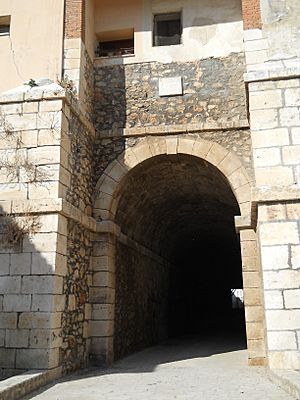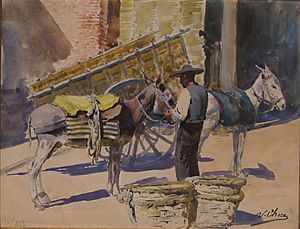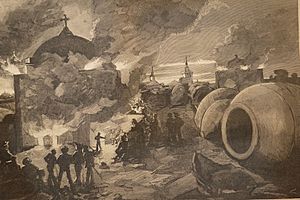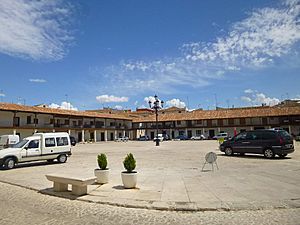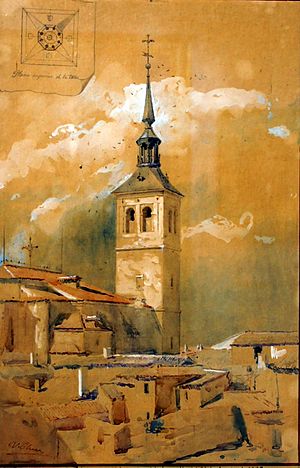Colmenar de Oreja facts for kids
Quick facts for kids
Colmenar de Oreja
|
|||
|---|---|---|---|
|
Municipality
|
|||
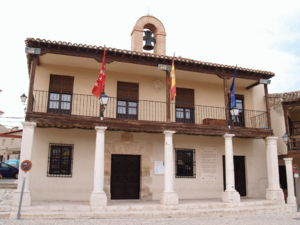
City Hall.
|
|||
|
|||

Location of Colmenar de Oreja in Madrid
|
|||
| Country | |||
| Autonomous community | |||
| Comarca | Las Vegas | ||
| Municipality | Colmenar de Oreja | ||
| Area | |||
| • Total | 126.3 km2 (48.8 sq mi) | ||
| Elevation | 761 m (2,497 ft) | ||
| Population
(2018)
|
|||
| • Total | 7,902 | ||
| • Density | 62.565/km2 (162.04/sq mi) | ||
| Demonym(s) | Colmenaretes | ||
| Time zone | UTC+1 (CET) | ||
| • Summer (DST) | UTC+2 (CEST) | ||
| Postal code |
28380
|
||
Colmenar de Oreja is a town and municipality in the Community of Madrid, Spain. It's part of the Las Vegas area. The town was once involved in a long siege that lasted seven months in 1139.
Contents
Where is Colmenar de Oreja?
Colmenar de Oreja is located in a flat area between the Tagus and Tajuña rivers. It sits about 753 meters above sea level. The highest point in the area is Navarredonda, at 780 meters. The lowest point is 515 meters, where the river enters the district.
The town is surrounded by other municipalities. To the north are Valdelaguna, Chinchón, and Villaconejos. To the south, it borders the Toledo province and towns like Villarrubia de Santiago, Noblejas, Ocaña, and Aranjuez. To the east, you'll find Belmonte de Tajo, Villarejo de Salvanés, and Villarrubia de Santiago. To the west, it's next to Aranjuez.
How to Get There
Colmenar de Oreja is about 50 kilometers from Madrid, the capital city. You can only reach it by road now, as its old train connection no longer exists.
There are regular bus services available. You can take Line 337 from Madrid or Line 430 from Aranjuez to get to Colmenar de Oreja.
What's in a Name?
The name Colmenar de Oreja comes from the Latin words "Apis Aureliae." This means "Apiary of Aurelio." An "apiary" is a place where bees are kept, like a beehive farm.
The name likely came from the Aurelia Fort (which later became the Castle of Oreja). This fort might have been named after a Roman consul called Aurelio. Over time, small villages grew around the fort. One of these villages focused on beekeeping, and that's how it got the name "Apis Aureliae," which later became Colmenar de Oreja in Spanish.
A Look Back in Time
Early Settlements
The first signs of people living in Colmenar de Oreja date back to the Second Iron Age. These early communities lived in caves along the Tagus river and at a place called Los Castrejones. These areas were home to the Carpetani people. Historians like Polybius and Livy wrote about a big battle in 220 BC in this region, where the Carthaginian general Hannibal defeated a large army of local tribes.
Roman and Visigothic Times
After the Romans took over, Julius Caesar gave land to his soldiers. This led to the creation of Roman farms, with the most important one being the villa of Aurelia. This villa grew into a well-known Roman, Hispano-Roman, and Visigothic city, which is where modern Colmenar de Oreja began. Even then, Colmenar was a settlement known for beekeeping and for its stonework, using limestone from local quarries that are still there today.
The Castle of Oreja
Around the 10th century, Arabs built a fort near the city of Aurelia and the Tagus river. This became known as the Castle of Aurelia, or Castle of Oreja. This castle was very important. After being fought over many times, King Alfonso VII finally captured it in 1139 AD. This led to the creation of the Fuero del Castillo de Oreja on November 3, 1139. A "Fuero" was a special document that gave rights and laws to a town. This document was so important that it became a model for other towns, including Toledo and Madrid. You can find this historical document in the National Historical Archive (Spain).
The Order of Santiago
In 1171, King Alfonso VIII gave control of a large part of the area, including the Castle of Oreja and its villages, to the Order of Santiago. This was a powerful military and religious order. Under their leadership, Colmenar grew a lot. Other nearby villages like Castellanos, San Miguel, and San Pedro eventually disappeared as people moved to Colmenar.
Royal Connections
After the Treaty of the Bulls of Guisando, King Enrique IV set up his court in Colmenar de Oreja. Both Enrique IV and Isabel (later Queen Isabella) signed many important decisions while in Colmenar. The town's Santa María la Mayor Church was even where a famous statement supporting Joanna la Beltraneja was made. Later, supporters of Princess Isabel and her opponents made peace in the important Vistas de Colmenar de Oreja.
In 1540, King Carlos I of Spain gave Don Diego de Cárdenas y Enríquez the title of "First Lord of Colmenar de Oreja y Oreja." Later, in 1625, this title became a "County." Many important buildings were built or improved in Colmenar de Oreja between 1500 and 1700, including the expansion of the Santa María la Mayor church and the founding of monasteries.
Modern Recognition
In 1922, King Alfonso XIII of Spain officially gave Colmenar de Oreja the title of "City." This was to recognize its long history and its growing industries and strong farming. On December 26, 2013, the town was declared a Bien de Interés Cultural, which means it's a site of cultural interest and protected.
Farming in Colmenar
The main crops grown in Colmenar de Oreja are vineyards (for grapes) and olives. Growing olive trees and making olive oil has been a tradition here since Roman times. In 1750, there were 105 olive oil mills! Today, only one remains, run by local farmers as a cooperative. Most of the olives grown are the "cornicabra" type, which have a fine, long fruit.
Colmenar also plays a big part in the Vinos de Madrid wine region. Its nine wineries produce important wines within the Arganda subzone, which has a special Denominación de Origen (a quality mark for food and drink).
Amazing Buildings
- Plaza Mayor (Main Square): This beautiful square started being built in 1676 and was finished in 1794. It's a great example of a typical Castilian square with arches. The Town Hall is located here. The southern side of the square connects to the Zacatín Gardens and a stone tunnel called Arco del Zacatín. This tunnel goes under the square, connecting two sides of the valley. The Plaza Mayor has been used as a setting for many movies and TV shows. During festivals in May and September, a temporary bullfighting ring is set up here for traditional events.
- Teatro Municipal Diéguez (City Theatre): This theatre is built where an old hospital used to be. In the 19th century, it was known as the Corral de Comedias. Today, it's named after Antonio Diéguez Cruz, a famous actor from Colmenar who was born in 1904.
- Ulpiano Checa Museum: This museum holds the largest collection of works by Ulpiano Checa (1860-1916), a famous painter. His art often shows historical scenes from the late 19th century, as well as orientalist and everyday life paintings. The museum building has a small garden with a statue of the painter and a monument celebrating the town's limestone and large terracotta jars (tinajas).
- Iglesia de Santa María la Mayor: This church was built by the Order of Santiago in the 13th century and later expanded in the 16th century. In recent years, its paintings and floor have been restored. In 2009, a new organ was added, donated by a local resident.
- Ermita del Cristo del Humilladero: This chapel is considered one of the most important monuments in the city. It's a mix of buildings from different time periods, including a 16th-century chapel and later additions in the Baroque style. It's dedicated to the Santísimo Cristo del Humilladero, who is the patron saint of Colmenar de Oreja.
- Convento de la Encarnación del Divino Verbo: This convent belongs to the Augustinian Recollect Nuns and is known locally as the "Convent of the Nuns." It's a large complex built in the mid-17th century, founded in 1636.
Famous People from Colmenar
- Isidoro Arredondo (1655–1702), a painter
- Ulpiano Checa (1860–1916), a painter
- Manuel Blanco Játiva (1898–1952), a flamenco singer
- Francisco López (1554), a painter
- José María Moralejo (1774–1849), a writer
- Diego de Cárdenas y Enríquez, who in 1540 was granted the title of first Lord of Colmenar de Oreja y Oreja by Carlos V
- Marcela de Ulloa (?-1669), who was a maid of honor to the infanta Margarita Teresa de Austria
See also
 In Spanish: Colmenar de Oreja para niños
In Spanish: Colmenar de Oreja para niños



